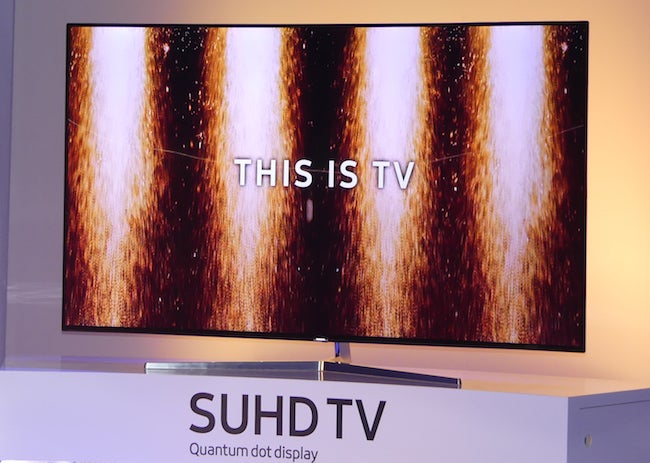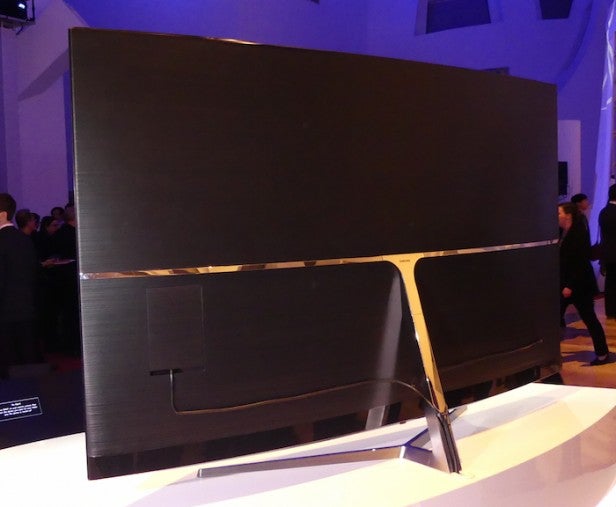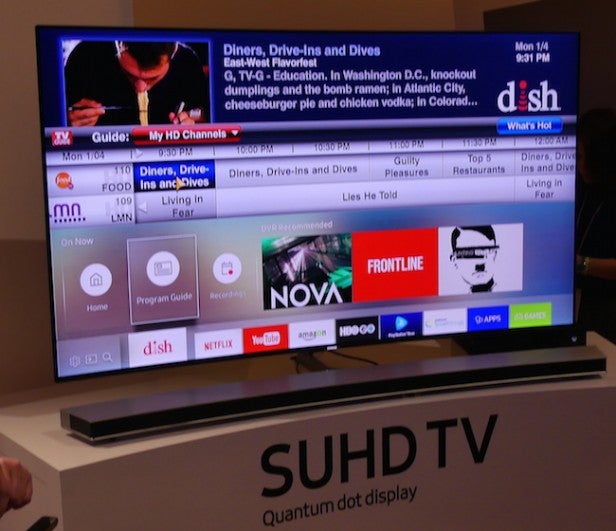Samsung 65KS9500 Review
Samsung 65KS9500
Hands-on: Samsung's Ultra HD Premium TV sets pulses racing

Verdict
Key Specifications
- 65-inch LCD screen
- Native 4K UHD resolution
- Ultra HD Premium ready
- HDR playback
- 1,000-nit brightness
Hands-on with the Samsung 65KS9500
Samsung normally makes the first big TV technology splash at every CES
by hosting an exclusive, invite-only event two nights before the show
actually begins. And it did the same again this year with an event at
the Keep Memory Alive Center in Las Vegas.
While the venue was
suitably swanky and the usual Samsung fighting talk evident, this time
round the product on show didn’t quite live up to the hype.
Watch our round-up of the best TVs at CES 2016
That
product was the 65KS9500: a new high-end LCD TV series that – while
certainly not without its charms – doesn’t deliver the same
benchmark-setting and ground-breaking thrills we’ve come to expect from
Samsung’s headline CES TV set.
Things
start off quite well, thanks to a design that returns to using a slim
screen frame in place of the slightly chunky look of Samsung’s 2015 TVs.
In fact, with a rivet- and screw-free rear, highlighted by a full-width
metal strip running across its centre, the 65KS9500 incorporates the
360-degree design that TV manufacturers are convinced we’re all looking
for.

The 65KS9500 also managed to be the first of the TVs on
show at 2016’s CES to boast an Ultra HD Premium logo (covered in detail
in our dedicated feature). It sports a native resolution of 3,840 x 2,160 pixels, while its peak brightness is capable of exceeding 1,000 nits.
In
addition, its colour performance is capable of delivering more than 90%
of the Digital Cinema Initiative (DCI) P3 spectrum. These are all
crucial specifications for delivering high dynamic range (HDR) 4K
content to the sort of standard the AV industry believes we should be
viewing it.
A number of other TVs at the CES 2016 also meet the
Ultra HD Premium performance requirements, but the striking thing here
is that the 65KS9500 does so while using an edge LED lighting system.
I’d
strongly expected 2016 to be the year where direct LED lighting – where
the LEDs are positioned directly behind a TV’s screen – became almost
de rigueur where HDR-capable TVs are concerned. However, here Samsung is
leading the charge with an edge-lit model.
Samsung does have a
flagship direct LED model lined up in its 2016 plans: the 65KS9800
series. However, it wasn’t close enough to completion to make a debut at
CES.

The 65KS9500 also sees a return to using Quantum Dot technology. Although some might perceive it to be an older technology, the reason for the return
is that a specially modified version of Quantum Dot makes it easier for
Samsung to deliver the significant 30% or so jump in brightness you
get with the 65KS9500s versus 2015’s JS9000 edge-LED HDR TV models.
This
brightness is delivered on the 65KS9500s, claims Samsung, at the same
time that the screen’s native black-level response has been improved – and
without leading to significantly more energy usage. The 65KS9500 also
apparently uses improved reflection filtering to aid its contrast
performance, as well as hopefully reducing the extent to which
reflected light distorts across curved screens.
Aside from its
mostly HDR-focused picture advances, the main new tricks of the 65KS9500
are based around its smart features.
Particularly welcome is a much-improved, two-tier Tizen-based smart interface. The bottom tier shows up
to 40 apps in any order of your choosing – the “apps” include
external sources and the tuners, as well as streaming services and
games. The tier above displays links to content from within the app
you have highlighted in the bottom tier. So if you highlight Netflix,
recommended shows from Netflix appear for instant access in the tier
above.
It’s slick, well presented, and really does provide you with fast access to a huge amount of content.
Also
pretty cool on the smart TV front is the ability of the 65KS9500 to
automatically recognise any equipment you attach to it and then have its
remote control take over the operation of that external gear. It’s like
having your own instant universal remote without the usual setup
headaches.
The system works using a combination of identification
data sent via HDMI, analysis of external device metadata, and even logo
recognition – Samsung claims it can recognise around 90% of
all external devices on the market. 
We
do wonder how effectively control of a device as complex as, say, a
Sky box will translate to a new Samsung smart remote that has only
five or six buttons. In principal, however, Samsung’s bid to reduce
your remote count is a great idea.
Last but not least on the
smart TV front, the 65KS9500 supports the Internet of Things. A hub
built into the TV will work with a free USB dongle to enable the TV to
hook up with more than 200 other “SmartThings” devices – for a full
list, head to the SmartThings website).
Samsung was running demos
showing how switching the 65KS9500 to its Cinema mode could
automatically turn down your smart lamps. In another example Samsung showed how someone ringing your
connected doorbell could result in video from your connected security camera
appearing on the TV, along with the option to unlock your connected
door!
First impressions of the 65KS9500’s picture quality are
positive – to a point. Playback of a variety of HDR UHD sources –
including footage of Mad Max Fury Road delivered by Samsung’s new Ultra
HD Blu-ray player – revealed a picture of remarkable brightness for an
edge Edge LED model.
Pictures are driven out of the screen far more
forcefully than they were even by the impressive JS9000 models of 2015. This helped to bring out the HDR highlights of all those explosions and
flaming car exhausts in Mad Max, while also making colours look generally
punchier.
There also appears to be more subtle shading in dark
areas than we’ve seen previously from any edge LED TV, along with less
obvious signs of light blocking and haloing around the brightest
highlights in the image. Black levels appear markedly deeper too; the
screen has to be capable of hitting 0.05nits to earn the Ultra HD
Premium badge.
However, note that it’s difficult to truly judge the 65KS9500’s light handling until I get to view it
in a much darker environment than that of the Keep Memory Alive Center!
I should also add that subtle light-blocking artefacts were evident on occasion, even under the event’s bright lights, as well as one
or two motion-processing glitches. Hopefully, both can be resolved via calibration – once we get a 65KS9500 in for proper
testing.
There’s no doubt that there’s plenty to like about the
65KS9500 in terms of features and performance. And yes,
there are a few genuine innovations tucked away in there. However, I also can’t deny that it didn’t deliver the sense of awe felt having seen something truly ground-breaking, which is something I experienced at the
launch of the original SUHD TVs last year.
How we test televisions
We test every TV we review thoroughly over an extended period of time. We use industry standard tests to compare features properly. We’ll always tell you what we find. We never, ever, accept money to review a product.

